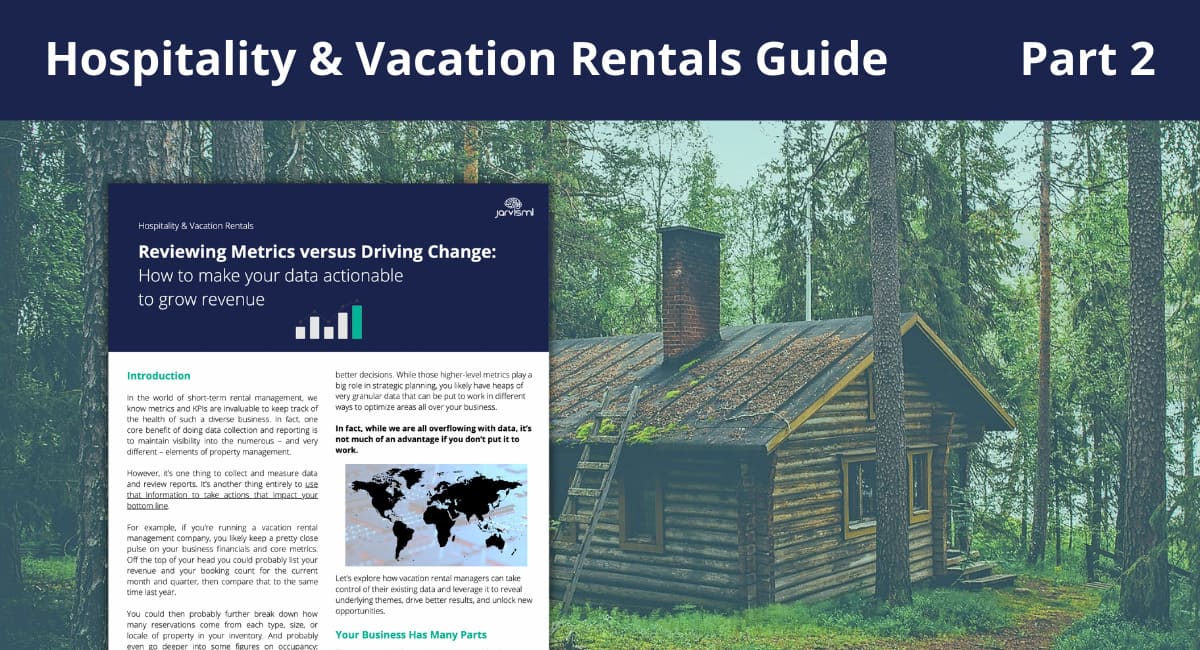This is post number two of our two-part blog series. You can find the first post here. Both are pieces of our Guide titled: “Reviewing Metrics versus Driving Change: How to make your data actionable to grow revenue”. We explore how to make better use – real actionable use – out of the data you have.
Given all the data stored by vacation rental managers, the opportunity to apply those learnings and make impactful change tends to be quite large.
In part one, we walked through the different types of data that gets stored and tracked, and some examples of how you might put that to work to create a more efficient business. We also narrowed our focus from a wide scope down to just the guest acquisition funnel: bookings and revenue.
Now we get even more specific talking about taking action.
…continued from Part 1…
Okay… you get it. You have data. Now what?
Part 1: The people side of the equation
If you hire a good data analyst or a more specialized data scientist, that employee can be the key to unlocking insights that lead to action. Direct, revenue-improving or efficiency-driving action.
Hiring more than one “data guru” means you can learn and do even more – depending on the size and sophistication of your operation. Each can tackle different parts of your data sets, focus on specific areas of your revenue funnel, and collaborate to come up with more creative solutions.
Good analysts – who are both contextualized with your business and experts in data analysis techniques – will be able to join together the stored information across your platforms and systems to trace the path of wins, and of losses. Your data people will have the skillset to identify factors and trends that make one campaign more successful than another, or which guest profiles are more likely to book next.
Let’s look at a scenario.
You might ask where your prospective guests are getting “lost” in your booking process and dropping out? If a certain category of people are clicking your email promotions but aren’t converting, your analysts can tell you this in detail. An example of that poor-converting audience segment could be:
- located in California,
- show interest in winter season properties,
- have never actually booked from you,
- but have in the past searched for specific property amenities on your website.
If your team can granularly identify some audience segments like this that aren’t converting well, the creative juices can start flowing about how to improve.
From there, you have the power to take action to change something: maybe personalizing the messaging to that audience; maybe offering certain promotions for their preferences; or even create some inspiring or educational content to address that group; and so on.
Test a solution and look at the results. Do more of what works and less of what doesn’t. Your analysts should be able to help identify trends as well: the data may suggest that recommending listings with a special amenities to those folks tends to convert better.
Sound hard? Well, it can be. While some data analytics can be straightforward, it can also get incredibly intricate given more data, more complexity, and more goals to achieve.
But it’s a necessary component of maintaining success today. Business fundamentals require collecting data so you can understand the health of your business. But modern business fundamentals require putting that data to work for you – making it actionable to improve your business.
Part 2: The supporting technology and tools
Analysts are a powerful starting point to turning data into action… and into more revenue.
However, the next step is enabling your people with tools. We can draw plenty of insights only using a spreadsheet (Excel, Google Sheets). And even more can be understood with data analytics query languages (SQL, Python, R, etc).
But there is a reason so many technology companies are entering the market. Software can tremendously enhance analysis and optimization capabilities. Being able to quickly visualize your data makes decision-making so much easier. Tools like Tableau or Looker do a great job at that: simplifying complex data.
Extending past those level 1 and level 2 tools, many tools have been developed to automatically update your website, update your database, or send out proactive alerts based on trends in the data.
There are emerging technologies that not only store, process, and show you analytics from your data, but that will also run the complex analyses for your analysts – identifying areas of improvement or which action to take next. Some can even automatically apply that logic to your campaigns or website via integrations!
A common misconception in the industry is that to add revenue you must add inventory. But that idea is missing parts of the equation. In reality, you can increase revenue without increasing property count with automated data optimization technology that can maximize profitability on each booking.
Further, when tools start using artificial intelligence and machine learning, you are able to precisely forecast your bookings and revenue for next week or next month – or predict which customer, which property listing, and with which price will most likely book with you next.
In 5 to 10 years, who knows what will be possible!
Stepping back: Making it actionable
I recently listened to some vacation rental management thought leaders discussing the metrics they looked at to understand their business. I’ll highlight two categories:
- First, regarding reservations and how booking agents performed: conversion rate, number of calls versus emails and chats, and other agent-specific metrics.
- Second, what source their reservations came from – calling in, online campaigns, chat, a booking service, an OTA, etc.
Those thought leaders also said “what they did” with those insights – but the takeaways weren’t very specific: “As we notice these numbers change over time, we can understand the feel for the business and make staffing decisions or shift budget appropriately. We can identify trends and ask our employees questions to get a deeper understanding of what’s going on.”
Maybe you already see where I’m heading… it’s not always clear how to make insights actionable to change your business.
In fact, it can be very hard. And only gets harder with the more data you collect.
So what is actionable?
For those categories – reservation conversion rates and booking sources – the highest leverage way to drive improvement is through analysis and optimization. Discussions with the management team help to define your strategic direction, but executing that vision is best served through technical people wielding powerful tools.
When it comes to the granular aspects of your digital, guest acquisition funnel – you’re best served by tactical insights that drive automated action through continuous learning, analysis, and execution.
That is being data-driven.
If you already have a team of analysts working with your sales and marketing data to make adjustments and improve conversion rates, you’re doing this work already.
If you’ve partnered with a vendor that calculates Dynamic Pricing or optimizes your advertising spend, you’re investing in this.
The key is to leverage the people and technology available today to absorb all of your information and unleash its potential! The right people and tools can dramatically change the efficacy and profitability of your guest acquisition efforts.
A real life example
We partnered with a short-term rental company that was looking to understand what their data would say about a segment of their unengaged CRM leads. They had enough information stored to learn and act, but just hadn’t taken the next step.
The Jarvis ML platform was put to the task. It ran business data from a few key sources – like customer profiles, purchase history, and website analytics – through a number of models to predict some specific outputs:
- Which leads had the highest potential value to the company?
- Which properties were each of these leads most likely to book next?
- What price point applied to each property would maximize the likelihood of that lead actually converting?
- When would be the best time to engage each lead?
The Jarvis ML outputs were then easily integrated into company’s CRM and email marketing software (Salesforce CRM and Marketing Cloud). A series of email promotions were sent using the personalized property and price recommendations for each lead at the suggested time.
Conversion tracking data from those emails was also ingested by Jarvis ML, so the vacation rental company leaders could probe our results. Turns out that our annual platform costs were paid for twice-over in less than two weeks as a result of the bookings generated from the presumed unengaged leads. Over time this amounted to millions of dollars in incremental monthly revenue.
Automated analysis, predictions, and campaign personalization through automation… that’s what I would call an extremely actionable insight!
The takeaway is this: the analysis and calculations done within a tool like above – or done by your team of data folks – can be put to work directly in campaigns and drive growth. Software can process data much more quickly and accurately than people, but tools need guidance to focus in the right direction.
Thus, we always recommend combining good people and good tools.
What you can prioritize next
There may not be a blueprint for how to exactly turn all of your data into insights, and insights into action… but that’s why you hire smart people, talk to others in the industry about their experience and recommendations, and utilize technology. It’s challenging to do everything yourself, but it lightens the load significantly when you get help.
In the spirit of being actionable, we’ll provide some recommendations for next steps.
- Take stock of your technology “stack”
- Which tools are you using at each stage of the funnel? What types of data are they collecting? (Some examples: a CRM like Salesforce, Google Analytics for your website tracking, AutoHost for guest security, MailChimp for marketing emails, Guesty or Lodgify for property and channel management, feedback through SurveyMonkey, etc)
- Which tools are you using at each stage of the funnel? What types of data are they collecting? (Some examples: a CRM like Salesforce, Google Analytics for your website tracking, AutoHost for guest security, MailChimp for marketing emails, Guesty or Lodgify for property and channel management, feedback through SurveyMonkey, etc)
- Given all of those data sources, do you have a data analyst in place to join and analyze the data for optimization?
- Are they doing higher-level weekly summaries? Or are they running deeper analysis that inform insightful decisions about your guest acquisition?
- Ask those people what tactics they are using to optimize website experience, marketing campaigns, and conversion rates. If you don’t yet have any people in place – then you know what to do!
- Ask for a monthly summary of what work is being done on using data to drive action.
- It helps to have something non-numerical here to name what actions are being taken. Then it should include the results of that effort.
- Specifically, review the metrics for individual campaigns and channels: look for any upticks or downward trends that may have come from the actions of your team. Suggest to your team new ideas for how to use your data to your advantage.
- Look out for technology, tools, and partners that can help you and your team of analysts do an even better job.
- Read articles (like you’re doing now); meet people; go to conferences; take calls with thoughtful partners. Change is always underway, and there may be a solution that perfectly fits your needs – you just need to hear about it somehow!
- Evaluate and test new technologies! Tools help in many areas to improve digital acquisition results. Here are some examples.
- Customer Data Platforms and Data Visualization Tools aggregate all of your data into one view and allow easier reporting and graphs.
- Dynamic pricing tools can process some bits of your data to generate price recommendations automatically.
- Forecasting tools can help predict the future and set your expectations in advance, based on your historical data.
- Newer applications can plug into your core systems (PMS, CRM, Google Analytics, email marketing) and extract insights and highlight hard-to-find trends.
- Automation + machine learning tools can generate acute predictions based on the insights in multiple datasets, and then apply personalized recommendations (per guest or per property) into your website, CRM, and even into marketing emails.
Investing in both technology and in data experts is the highest leverage way to transform your data into actions that grow revenue and improve your business.





